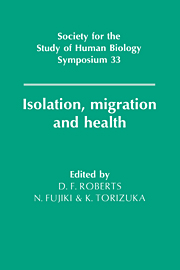Book contents
- Frontmatter
- Contents
- List of contributors
- Preface
- 1 The legacy of the IBP: Presidential Address
- 2 The distinction between primary and secondary isolates
- 3 Time trends in the break-up of isolates
- 4 Factors influencing the frequency of consanguineous marriages in Japan
- 5 Break-up of isolates
- 6 Isolates in India: their origin and characterisation
- 7 Consanguineous marriages and their genetical consequences in some Indian populations
- 8 Biomedical and immunogenetic variation in isolated populations in India
- 9 Genetic distance analyses in Israeli groups using classical markers and DNA polymorphisms in the β globin gene
- 10 Non-random distribution of Gm haplotypes in northern Siberia
- 11 Allele frequency estimation
- 12 Genetic affinities of human populations
- 13 Inherited neurological diseases in island isolates in southern Japan
- 14 Serological and virological evidence for human T-lymphotropic virus type I infection among the isolated Hagahai of Papua New Guinea
- 15 Analysis of genes associated with hypercholesterolaemia in the Japanese population
- 16 Migrant studies and their problems
- 17 Tokelau: migration and health in a small Polynesian society - a longitudinal study
- 18 Micromigrations of isolated Tuareg tribes of the Sahara Desert
- 19 Population structure in the eastern Adriatic: the influence of historical processes, migration patterns, isolation and ecological pressures, and their interaction
- 20 Diabetes and diabetic macroangiopathy in Japanese-Americans
- 21 Diabetes and westernisation in Japanese migrants
- 22 Environmental factors affecting ischemic heart disease
- Epilogue
- Index
1 - The legacy of the IBP: Presidential Address
Published online by Cambridge University Press: 05 March 2012
- Frontmatter
- Contents
- List of contributors
- Preface
- 1 The legacy of the IBP: Presidential Address
- 2 The distinction between primary and secondary isolates
- 3 Time trends in the break-up of isolates
- 4 Factors influencing the frequency of consanguineous marriages in Japan
- 5 Break-up of isolates
- 6 Isolates in India: their origin and characterisation
- 7 Consanguineous marriages and their genetical consequences in some Indian populations
- 8 Biomedical and immunogenetic variation in isolated populations in India
- 9 Genetic distance analyses in Israeli groups using classical markers and DNA polymorphisms in the β globin gene
- 10 Non-random distribution of Gm haplotypes in northern Siberia
- 11 Allele frequency estimation
- 12 Genetic affinities of human populations
- 13 Inherited neurological diseases in island isolates in southern Japan
- 14 Serological and virological evidence for human T-lymphotropic virus type I infection among the isolated Hagahai of Papua New Guinea
- 15 Analysis of genes associated with hypercholesterolaemia in the Japanese population
- 16 Migrant studies and their problems
- 17 Tokelau: migration and health in a small Polynesian society - a longitudinal study
- 18 Micromigrations of isolated Tuareg tribes of the Sahara Desert
- 19 Population structure in the eastern Adriatic: the influence of historical processes, migration patterns, isolation and ecological pressures, and their interaction
- 20 Diabetes and diabetic macroangiopathy in Japanese-Americans
- 21 Diabetes and westernisation in Japanese migrants
- 22 Environmental factors affecting ischemic heart disease
- Epilogue
- Index
Summary
At the inception of the International Biological Programme in the early 1960s, it was recognised that man's adaptability had led to rapid and far-reaching changes in the environment. The coordinated study of biological variability and management of natural resources promoted through the International Biological Programme was designed to examine the functional relationship of living things to their environment. There was concern both for the needs of man and for greater ecological understanding. The general aims of the human adaptability section of the programme (Collins & Weiner, 1977) were to survey human adaptability in a wide variety of climates, terrains and social groupings, and so to increase understanding of the biological basis of adaptation, and to apply this knowledge to health and welfare problems. In order to implement these goals, an integrated approach was required, utilising standard methods drawn from the many disciplines of human biology.
During the operational phase of the programme, 1967-72, some themes were explored worldwide, namely growth and development, physique and physical fitness, climatic tolerance, genetic constitution, nutrition, and disease susceptibility. Others were on a regional basis. There were teams at work in the circumpolar and cold climates, studying the Eskimo, Lapp, Ainu, and Aleut; in the hot climates, as in central Africa, among Babinga Pygmies, in the African savana, among west African Nigerians, southern and other Bantu peoples, and in east Africa; in high altitudes, as in Chile, the Himalayas, Ethiopia, the Andes and Caucasus. Comparisons between rural and urban communities were the subjects of long-term study in several countries, as in the Kumiyama and Nihonsan study in Japan, the Framingham study in the USA, as well as in Bulgaria, Poland and Czechoslovakia.
- Type
- Chapter
- Information
- Isolation, Migration and Health , pp. 1 - 16Publisher: Cambridge University PressPrint publication year: 1992



